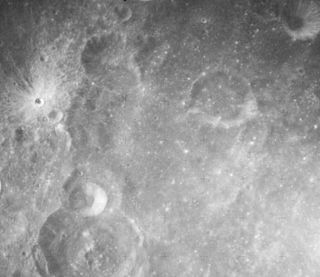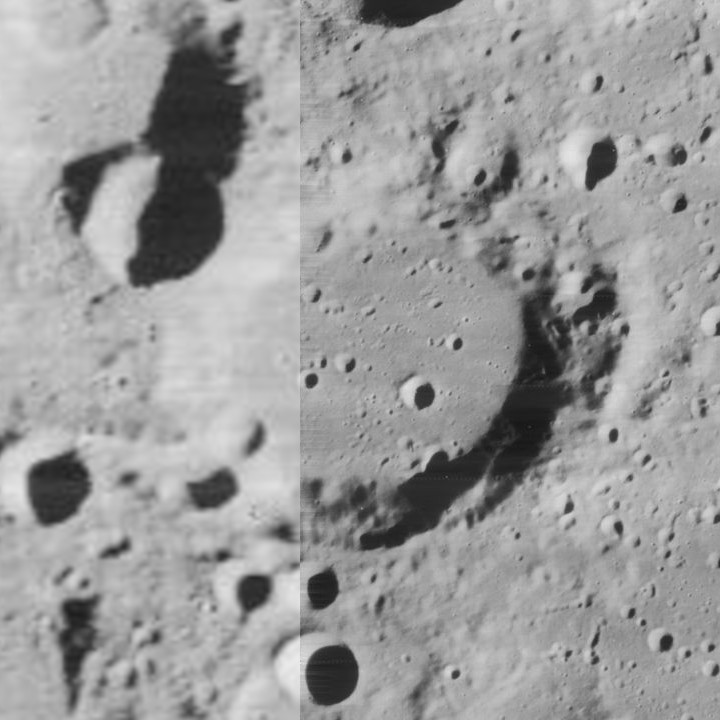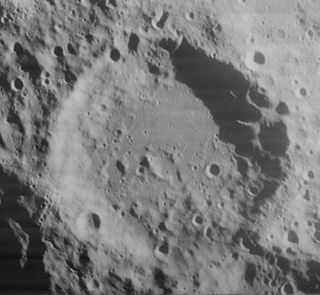
Babbage is an ancient lunar impact crater that is located near the northwest limb of the Moon, named after Charles Babbage. It is attached to the southeastern rim of the prominent crater Pythagoras. The crater remnant named South intrudes into the southeastern floor of Babbage.

Barrow is an old lunar impact crater that is located near the northern limb of the Moon. It lies between the crater Goldschmidt to the northwest and the irregular formation Meton to the northeast. To the southwest is W. Bond.

Bergstrand is a lunar impact crater that lies on the far side of the Moon. It is located just to the southeast of the prominent crater Aitken, and northeast of the walled plain Vertregt.

Saenger is an ancient lunar impact crater that lies on the far side of the Moon, just beyond the eastern limb. It was named after Austrian rocketry scientist Eugen Sänger. To the west-northwest is the crater Erro, and due north lies Moiseev. To the northeast is Al-Khwarizmi.

Boole is a lunar impact crater that lies along the northwestern limb of the Moon, to the northwest of the crater Gerard. At this location it is viewed nearly from the side, and is very oblong in shape due to foreshortening. The crater formation is nearly circular, however, with a wide inner wall that has been worn and rounded due to subsequent impacts. It is named after George Boole.

Lindblad is an old lunar impact crater that is located on the far side of the Moon, just beyond the northwestern limb. This formation is located to the southeast of the crater Brianchon, and northeast of Cremona.

Fabry is a large lunar impact crater of the form termed a walled plain. It is located on the far side of the Moon, just beyond the northeastern limb. Parts of this area are sometimes brought into view by the effects of libration, but the terrain is seen from the edge and so not much in the way of detail can be observed.

Cannon is a lunar impact crater that is located near the east-northeastern limb of the Moon's near side. It lies just to the northwest of the Mare Marginis, and south-southeast of the crater Plutarch. Farther to the east-northeast is Hubble.

Casatus is a lunar impact crater that is located near the southern limb of the Moon. The north-northeast rim of the crater overlies a portion of the slightly larger crater Klaproth. Along the western rim, Casatus A intrudes somewhat into the interior, producing an inward-bowing rim. To the southeast of Casatus is Newton.

Cleostratus is a lunar impact crater near the northwest limb of the Moon. It lies to the northeast of the crater Xenophanes, and west-southwest of the prominent Pythagoras. From the Earth this crater appears highly elongated due to foreshortening.

Pascal is a lunar impact crater that lies near the northern limb of the Moon, on the western side of the pole. It is located to the north of the eroded crater Desargues, and just east of Brianchon. Pascal can be located by finding the crater Carpenter and then following the surface to the northwest towards the limb. However the visibility of this formation can be affected by libration.

Helmholtz is a lunar impact crater, approximately 110 kilometers in diameter, that is located near the south-southeast limb of the Moon. Attached to the south-southeast rim of Helmholtz is the somewhat smaller crater Neumayer. The larger crater Boussingault is nearly attached to the west-southwestern rim. The crater is named after German physicist and physician Hermann von Helmholtz

H. G. Wells is a lunar impact crater that is located on the far side of the Moon, behind the northeastern limb. It lies to the south of the crater Millikan, and to the northeast of Cantor. Just to the southeast is the smaller Tesla. The crater is named after the author H. G. Wells whose works include the 1901 novel The First Men in the Moon.

Dyson is a lunar impact crater, 63 kilometers in diameter, that lies on the far side of the Moon, past the northwest limb. It is located in the northern part of the surface, to the northwest of the crater Coulomb, and east of van't Hoff.

Hubble is a lunar impact crater that lies very near the east-northeastern limb of the Moon. At this location it is viewed almost from the side from Earth, and the visibility of this feature is affected by libration. It lies to the north of the Mare Marginis and northeast of the crater Cannon. About one crater diameter to the north-northeast is Lyapunov.

Comrie is a lunar impact crater. It is located on the rugged far side of the Moon relative to the Earth, beyond the western limb. Nearby craters of note include Ohm to the south-southwest, Shternberg to the southwest, and Parenago to the northeast.

Donner is a lunar impact crater on the far side of the Moon. It is located just to the northeast of the Mare Australe, behind the southeastern limb of the Moon. During favorable librations this part of the lunar surface can be brought into view of the Earth, but the site is viewed from the edge and so not much detail can be seen.

Dreyer is the remnant of a lunar impact crater on the far side of the Moon. It is located along the eastern edge of the Mare Marginis, about midway between the craters Ginzel to the north and Erro to the south-southeast. It was named after Danish-Irish astronomer John L. E. Dreyer.

Seyfert is a prominent lunar impact crater that is located on the far side of the Moon. It was named after American astronomer Carl Keenan Seyfert. It lies behind the eastern limb of the Moon, to the east of the crater Espin. Just to the north of Seyfert is the crater Harriot and equally close to the south is Polzunov.

Razumov is an impact crater on the far side of the Moon, beyond the northwestern limb as seen from the Earth. It lies along the southeastern outer rim of the walled plain Landau. Intruding slightly into the southern rim is the slightly smaller crater Petropavlovskiy. To the west-southwest lies Frost.






















